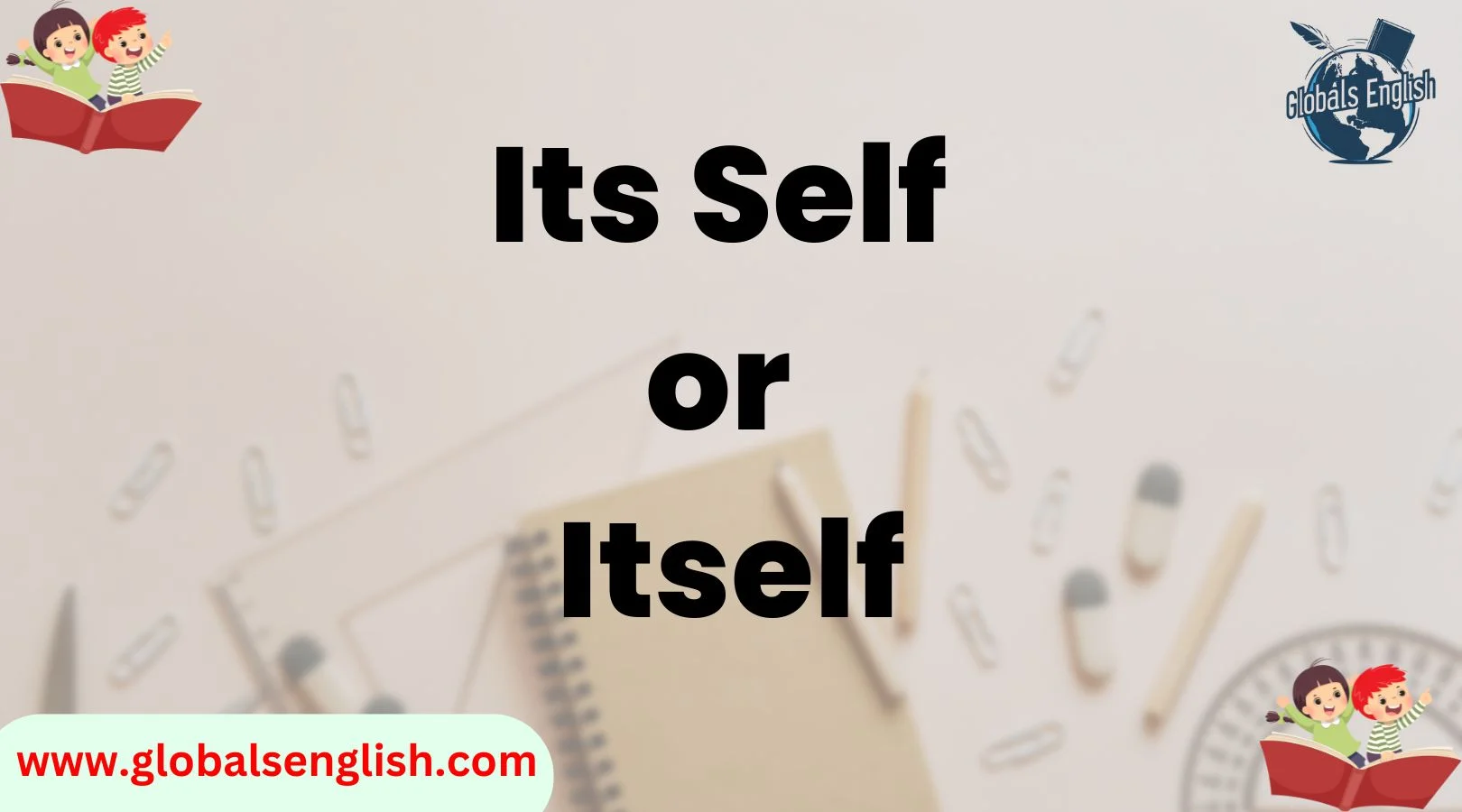When it comes to grammar, the small differences can make a big impact on clarity and professionalism. One common confusion that many people face is the distinction between “its self” and “itself”. This seemingly trivial mistake can slip into both casual writing and formal documents, causing unnecessary confusion. But why does this error happen so often? And which one is actually correct?
In this article, we’ll explore the correct usage of “itself”, the mistaken belief that “its self” is proper, and why understanding these differences is crucial for your writing. By the end, you’ll have a clear grasp of when to use “itself” and why “its self” is almost always wrong. Let’s dive into this important topic and clear up the confusion once and for all!
Understanding the Confusion Between “Its Self” and “Itself”
Why Do People Think “Its Self” is Correct?
The first question many ask is: Why do people get confused between “its self” and “itself”? The reason often lies in how the English language works, particularly in possessive and reflexive pronouns. In English, we commonly use possessive forms like “his self” and “her self”, so it’s understandable that people would think “its self” could follow the same structure. However, this is a common misconception. In fact, “its self” is incorrect in almost all contexts.
Another reason for the confusion comes from how we speak versus how we write. Spoken language often blurs grammatical rules, and people may casually say “its self” while thinking it’s right, especially when they hear others do it. This misstep then carries over into written English, where spellcheckers or autocorrect systems fail to catch the error. As a result, “its self” is mistakenly written in place of the correct “itself”.
Breaking Down the Two Terms: What Do They Mean?
The confusion mostly arises from a misunderstanding of how “its” and “itself” function. Let’s break down these two terms:
- “Itself” is a reflexive pronoun. Reflexive pronouns reflect the action back onto the subject of the sentence. It’s used when the subject and the object of a sentence are the same thing.
- “Its self” is a grammatically incorrect construction in modern English. The possessive pronoun “its” is used to show ownership, but “self” cannot be modified by a possessive adjective in this case.
When and How to Use “Itself” Correctly
What Are Reflexive Pronouns?
Before diving deeper into “itself”, it’s important to understand reflexive pronouns in general. Reflexive pronouns are used when the subject and the object of a sentence refer to the same entity. In the case of “itself,” the pronoun refers back to the subject “it.” Reflexive pronouns are also used for emphasis or to indicate that the action is performed by the subject on itself.
Here are the most common reflexive pronouns:
- myself (I did it myself)
- yourself (You should be proud of yourself)
- himself, herself (He did it himself; She prepared the meal herself)
- itself (The cat cleaned itself)
- ourselves (We finished it ourselves)
- yourselves (You did it yourselves)
- themselves (They solved the problem themselves)
As you can see, “itself” follows the same grammatical structure as these other reflexive pronouns.
Grammar Rules for Using “Itself”
Using “itself” correctly follows clear rules:
- Reflexive Use: “Itself” is used when the subject and the object of the sentence are the same thing. For example, The cat cleaned itself after playing outside.
- Never Possessive: “Itself” is never used to show possession. So, you should never write “its self” in place of “itself.”
- Emphasis: Sometimes “itself” is used for emphasis, to underline the idea that something is done without external help or intervention. For example, The company prides itself on its customer service.
Examples of “Itself” in Sentences
To help solidify your understanding of “itself”, here are some real-world examples:
- The door closed by itself. (The door is both the subject and the object; it acted on itself.)
- The computer rebooted itself after the update. (The computer did something without external influence.)
- The machine fixed itself. (Again, this means that the machine made a repair to itself.)
These examples demonstrate how “itself” is used when the subject performs an action on or to itself.
Is “Its Self” Ever Grammatically Correct?
Situations Where “Its Self” Could Be Used
While “its self” is almost always incorrect, there are very rare occasions when it might appear in writing. These instances occur when “self” is used as a standalone noun, in which case “its” is correctly serving as a possessive pronoun.
For example, when referring to concepts like “self-awareness” or “self-identity,” the phrase “its self” can technically be correct in terms of showing possession. However, even in these rare cases, it’s still far more common to use “itself” in modern English.
Examples:
- The robot demonstrated its self-awareness. (Correct use of “its” as a possessive.)
- The team embraced its self-image. (Again, the possessive “its” works here.)
In general, though, you’ll almost never encounter “its self” in standard English writing outside of these specialized cases.
Why “Its Self” is Almost Always Incorrect
Now that we know “its self” is rarely used and almost always wrong, it’s important to explain why. The possessive form of “its” is simply not meant to modify the word “self”. In modern English grammar, reflexive pronouns like “itself” were designed to reflect the subject back upon itself, not to show possession.
Most grammar experts, style guides, and proofreaders will tell you that “its self” is simply a mistake. Writing “its self” instead of “itself” often goes uncorrected in informal writing, but it’s never correct in formal or professional contexts.
Common Mistakes and How to Avoid Them
“Its Self” vs. “It’s Self”: The Apostrophe Problem
One critical mistake many people make is confusing “its” and “it’s”. This is a common error, and it often leads to incorrect usage of “its self” as well. Here’s the difference:
- Its is a possessive pronoun, meaning it shows ownership. For example: The dog wagged its tail.
- It’s is a contraction of “it is” or “it has”. For example: It’s going to rain today.
So, if you find yourself writing “it’s self”, you’re likely making two mistakes: one, using the contraction “it’s” when it should be “its,” and two, incorrectly inserting “self” where “itself” should go.
Real-World Examples of Incorrect Usage
Here’s a look at some incorrect examples of “its self” in real-world usage:
- Incorrect: The company prides its self on its sustainability efforts.
- Correct: The company prides itself on its sustainability efforts.
- Incorrect: The machine completed its self diagnostics.
- Correct: The machine completed its self diagnostics automatically.
The Historical Evolution of “Itself”
How Reflexive Pronouns Developed in English
The development of reflexive pronouns in English goes back hundreds of years. Old English had different ways of constructing pronouns, but over time, the reflexive form evolved into a more standardized system. English speakers began using “itself” in place of earlier variations, which included “its self” in some cases.
Why “Its Self” Never Became Standard English
The reason “its self” never became standardized is rooted in the development of reflexive pronouns and the shifting rules of possessive pronouns. Over time, it became clear that “itself” was the only form that fit grammatically with how reflexive pronouns are used.
How to Remember the Correct Usage
Quick Memory Tricks
To avoid common mistakes and ensure you always use “itself” correctly, here are a few quick memory tricks:
- Test the reflexive pronoun by replacing “itself” with “myself” or “yourself.” If it sounds natural, “itself” is the right choice.
- Think of possession: If you’re trying to show possession, use “its” (without the apostrophe), but don’t pair it with “self.”
Grammar Resources and Study Guides
If you’re still unsure, here are some helpful resources to perfect your grammar:
- Grammarly: Great for real-time corrections and explanations.
- Purdue OWL: Trusted by students and writers for solid grammar guidance.
- The Chicago Manual of Style: Excellent for understanding the rules of English grammar.
FAQs: “Its Self” vs. “Itself”
1. Is “its self” ever correct?
In most cases, no. “Its self” is almost always incorrect unless “self” is being used as a separate noun (e.g., “its self-awareness”). The correct term for reflexive use is “itself.”
2. Why do people mistakenly use “its self” instead of “itself”?
The mistake comes from the pattern of possessive pronouns (e.g., “his self” or “her self”) leading people to think “its self” follows the same rule. However, “itself” is a reflexive pronoun, not a possessive phrase.
3. Can “it’s self” ever be correct?
No. “It’s” is a contraction for “it is” or “it has,” so “it’s self” is always incorrect. You should use “itself” instead.
4. What is the function of “itself” in a sentence?
“Itself” is a reflexive pronoun used when the subject and object of a sentence refer to the same thing. For example:
- The cat licked itself.
- The machine restarted itself.
5. What part of speech is “itself”?
“Itself” is a reflexive pronoun used to emphasize or refer back to a subject that is also the object of the action.
Conclusion
In summary, “itself” is the correct reflexive pronoun, and “its self” is almost always incorrect. Understanding when to use “itself” will not only make your writing clearer but also more professional. By following the simple rules outlined above, you can ensure that you’re using reflexive pronouns correctly every time. Remember: reflexive pronouns help the subject and object of the sentence reflect back on each other, but “its self” does not fit into this structure.
So, next time you’re writing and come across this issue, you’ll know exactly how to avoid the confusion and write with confidence. Happy writing!

Mia Rose are the minds behind Globals English, a platform dedicated to making English learning simple, engaging, and effective. With a shared passion for education and communication, they bring years of experience in language teaching and curriculum development.
